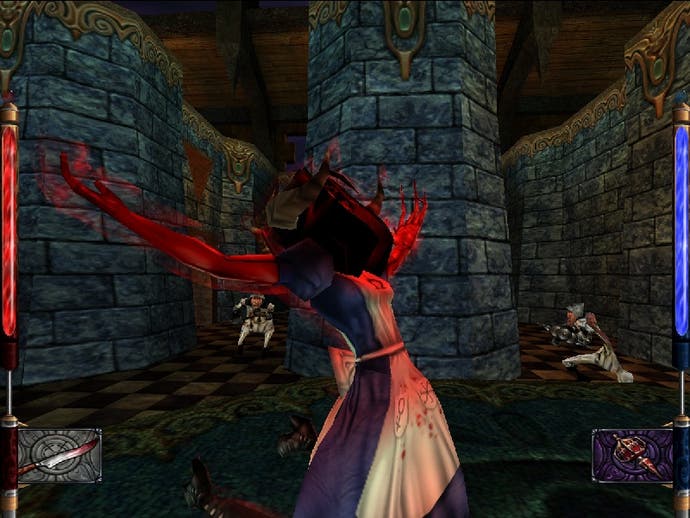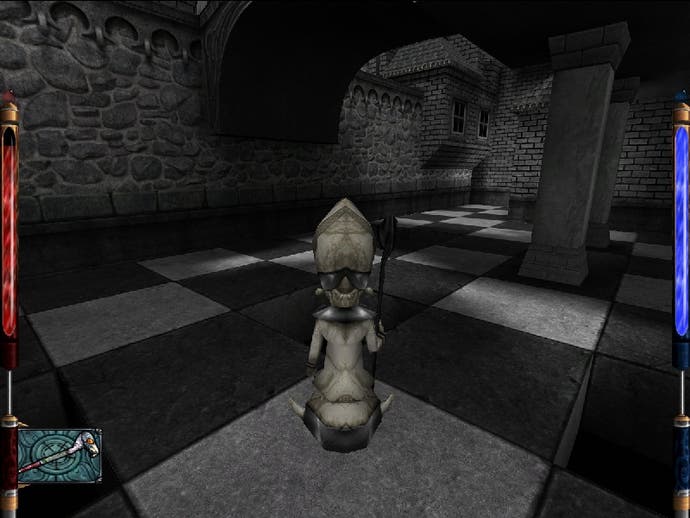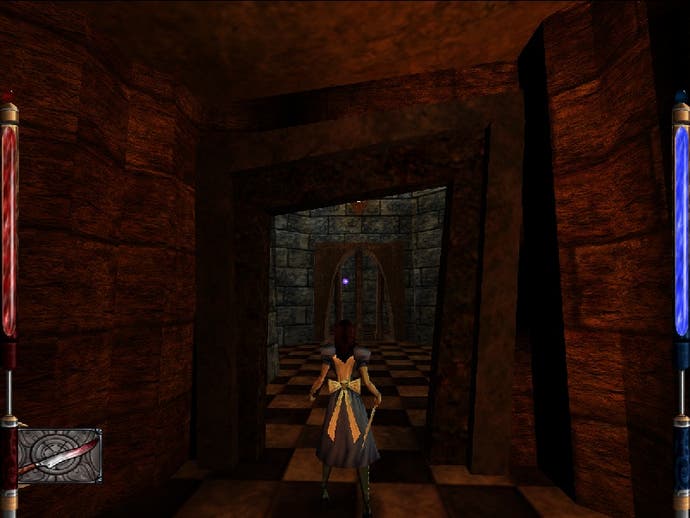Alice
A mysterious, enchanting use of the Quake III engine.
Wonderland has changed…
If there is one title that has stirred up controversy recently, this is it. Strangely, the focus of this debate has not been the gameplay merits, graphics or even the gothic atmosphere of American McGee's Alice, but rather the title. "Who is American McGee?" people cry, "and how can he defile Lewis Carroll's original work like this, and then attach his own name to it?". The answer to the first question is relatively simple - American McGee is a level designer who previously worked at iD software on games including Doom 2 and Quake. The second, however, is harder, and largely depends on how you perceive the games' take on the original stories. Alice is set some years after the original Wonderland tales. A fire in Alice's house killed both her parents, leaving her the only survivor - but psychologically scarred by the experience. Relegated to a mental asylum, she is drawn once again into Wonderland, only to find that the fairytale world has become twisted and evil under the influence of the Queen of Hearts. Thus begins Alice's quest to free Wonderland from tyranny - and herself from madness. Worthy of special mention is the excellent trailer for the game, which can be found at http://www.alice.ea.com, which shows off some of the superb FMV from the game.

Miyuki-chan, anyone?
The first thing that strikes you about the game is the sheer style with which the storyline and world are crafted. By taking familiar elements of the original books and twisting them into new forms, Rogue have produced a game that is a wonder to behold. This style is backed up by some of the best graphics to appear on the PC in recent times, powered by the Quake 3 engine. Technically, the engine is not much improved over that used in Quake 3, but the levels and characters are so well-designed that it looks like a brand new system. The game is split up into a number of themed worlds, with smooth transitions between most of them. The environments range from the monochrome castles of the chess pieces, to lush green forests and the mechanical hell of the Hatters' asylum. The constant variation in the levels and the wonderful graphics provide a compelling incentive to keep playing, but Alice does not fall short in the gameplay department, either. The game is played from a third-person perspective as you guide Alice through the part-platformer, part-combat levels. Quake-style mouse and keyboard controls are used, and whilst this takes a little bit of getting used to, it soon becomes second nature, and makes navigating the environments much easier. To aid the player further, a glowing crosshair acts as an aiming point for Alice's weapons, and can also provide an indicator of where it is safe to stand on ledges.

Mario 64 with knives
The platform elements of the game are pretty standard fare - jump across bouncy mushrooms, swing on ropes and make use of moving platforms. Again, though, Alice manages to make many of these well-trodden paths seem fresh by adding unique styling - for example, in one area platforms break up into a myriad of tumbling jigsaw pieces as you walk on them, and in another a huge steel ball chases you down a tunnel, shattering thin ice underneath you as you attempt to escape. The combat is less conventional, although reminiscent of some other third person games like Rune and Drakan. All but your default knife weapon use up Mana, which can be replenished by picking up crystals left behind by defeated foes, which also serve to replenish your health. Since the nature of the combat means that you will inevitably lose some health in each encounter, and using your long-range weapons costs Mana, the trick quickly becomes to make sure you gain more from killing a particularly enemy than you lose. This can add a great deal of tactics to the game, as some enemies drop larger crystals when defeated, although at times this can seem random and annoying as some large, tough enemies only give pitiful amounts of power back when dead.

Curiouser and curiouser…
The only real downside to Alice's gameplay is that it does get a bit tedious about half-way through the game, where there is a lot of combat with small but annoying foes and few puzzles. Fortunately the game picks up after that, with more interesting enemies that actually require real tactics to defeat, and some cleverly designed levels. The bosses are a bit of a disappointment, too - for the most part beating them involves little more than circle-strafing a lot and collecting the regenerating powerups that are present in every boss area. The audio in Alice is also exemplary - the music, fittingly enough, takes the form of twisted, haunting remixes of nursery rhymes and childhood songs, which matches the tone of the game perfectly. The sound is equally good - the effects match the action well, and the speech is wonderful, made even better by the well written script. In particular, I found Alice's dry humour and the Cheshire Cat's sarcasm a refreshing change after the soulless dialogue that accompanies many games.

Conclusions
All in all, Alice is something of an odd game. If you ignore the setting and graphics, there is a good but not outstanding action platformer underneath. However, with the polish and sheer excellence of the atmosphere generated, Alice becomes much greater than that. If you let the game draw you in, the fantasy world becomes much more real than you could imagine -and the game much more compelling. Alice is well worth a look, even if you feel that the original is best left unaltered.




